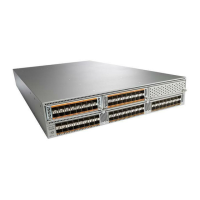Send documentation comments to n5kdocfeedback@cisco.com
2-7
Cisco Nexus 5000 Series NX-OS Interfaces Operations Guide, Release 5.0(3)N2(1)
Chapter 2 Cisco Nexus 5500 Platform Layer 3 and vPC Operations
Dedicated VRF For a Keepalive Interface
Figure 2-6 Control Traffic Forwarding in a vPC Topology
This topology is supported for unicast traffic but not for multicast traffic. In this topology, we
recommend that you use Layer 3 interfaces instead of vPC interfaces to connect routers to Cisco Nexus
5500 Platform switches whenever possible.
Figure 2-7, shows the recommended topology for connectivity of routers to a vPC domain. The router
connects with Layer 3 interfaces 1.1.1.2 and 2.2.2.2 to the two vPC peers and these interfaces are not
part of a vPC port channel.
Figure 2-7 Connecting a Router to a vPC Domain Using Layer 3 Interfaces
Dedicated VRF For a Keepalive Interface
Beginning in Cisco NX-OS Release 5.0(3)N1(1b), the Cisco Nexus 5500 Platform switch supports VRF
lite with a Layer 3 module and Enterprise license and you can create a VRF and assign the interface to
a VRF. Prior to this release, two VRFs were created by default: the VRF management and VRF default.
The management interface(mgmt0) and all SVI interfaces resided in the VRF management and VRF
default respectively.
239434
N5k-1 N5k-2
Po1:1.1.1.3
VLAN 10:1.1.1.1 VLAN 10:1.1.1.2
Routing protocol peer
1. Protocol packets
destined to: 1.1.1.1
and TTL-1
2. Packets are
redirected to CPU.
Software forwards
packet to “N5k-1.”
239435
N5k-1 N5k-2
L3 intf: 1.1.1.1
1.1.1.2 2.2.2.2
L3 intf: 2.2.2.1
Routing protocol peer

